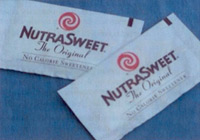MY EXPERIMENTAL SETUP

MY EXPERIMENTAL PROTOCOL
Summary of aspartame rat study protocol |
Protocol parameter |
Description |
Source of aspartame |
NutraSweet packets. |
Form of aspartame |
NutraSweet dissolved in drinking water, available 24 hours per day. |
Dosage |
Two packets of NutraSweet per eight ounces of water (about 80 mg of aspartame per each eight ounces); about 34 mg/kg of aspartame for males; 45 mg/kg for females. |
Duration |
Two years, eight months (about 138 weeks, where one month = about 4.3 weeks); until the spontaneous death of the animals. |
Rat strain |
Bred from two males, two females, each from different varieties of PetCo rats, including the Sprague Dawley strain. Maintained a genetic mix throughout the breeding, avoided mating brothers and sisters, mothers and sons, fathers and daughters. |
Number of rats in study |
Experimental group of 30 males, 30 females. Control group of 24 males, 24 females; a total of 108 rats. |
Type of feed |
Kaytee’s Supreme Fortified Daily Blend for Rat & Mouse and Kaytee’s Supreme Fortified Daily Blend for Hamster & Gerbil from a local feed store. |
DIET PEPSI, ASPARTAME OR NUTRASWEET? 
Because my family members were addicted to diet soda, at first I wanted to put Diet Pepsi in my rat’s water bottles. That idea was short lived. After turning a filled bottle upside down and attaching it to a cage, the liquid immediately started flowing out—carbonation pressurizes the bottle—so diet Pepsi wouldn’t work. It was just as well, because the cost of the soda would have been prohibitive over the course of the experiment.
I did not want to mix dry NutraSweet with rat food for several reasons. First, I wanted to simulate the effects of diet soda—a liquid. Next, NutraSweet is sold as powdered crystals that are tiny compared to the grains and alfalfa pellets comprising the food I fed my rats. I knew the powder would fall to the bottom of the food bowls, allowing the rats to avoid it.
I also knew from personal experience it would be hard to calculate the dosage, because so much food ends up in the trays under their cages. Finally, aspartame crystals may clump, allowing rats to avoid them. In The Bressler Report, the FDA task force reported the rats learned to eat around the DKP crystals.
I decided to mix pure aspartame in their water. In an Internet search for an aspartame supplier, I found only food and beverage manufacturers are permitted to purchase aspartame. Dr. Ralph Walton, a respected researcher, in the mid-90’s, experienced the same problem. No aspartame for sale for his study. (4)
The National Institute of Health evaluates a packet of aspartame-based sweetener such as NutraSweet contains 40 mg of aspartame.
I decided on putting the NutraSweet in their drinking water, at the rate of two packets—a total of 80 mg of aspartame–per each 8 oz of water.
A 12-oz diet soda has about 180 mg of aspartame, 15 mg of aspartame per oz., the amount in approximately 4.5 packets of NutraSweet.
According to the industry-run Aspartame Information Center website, a conservative estimate of the maximum dose of aspartame for humans per day, the Acceptable Daily Intake (ADI), as set by the FDA, is 50 mg/kg, approximately twenty cans of 12-ounce diet soda for a 150 lb. adult and six 12-ounce cans for a 50-pound child. Tabletop sweetener ADI is 97 packets for an adult and 32 packets for a child.
The animals in my study weighed on the average of 1 pound for males and 0.66 pounds for females. The ADI for the males was 16.9 mg and for the females 13.5 mg
To put these numbers into perspective, the aspartame received by my rats daily, was equivalent to two-thirds the aspartame contained in 8-oz of diet soda.
My masters degree is in mathematics.
RAT STRAIN
Most studies are done on rats that are genetically identical. According to a friend who runs a rabbit and mouse lab for a local bio-tech company, “Some vendors sell strains of rats that have gone through 30 generations of brother and sister in-bred mating.”
This concept seemed counter-intuitive to me. How do these strains of rats represent the general population? In “Mean Genes”, Jay Phelan and Terry Burnhan write: “Almost all animals avoid mating with close relatives because it makes for bad babies. From mice to monkeys, animals are reluctant to have offspring with siblings.
I bought my rats at PetCo and bred them for my experiment. I purchased rats of different colors, to get a genetic verity. I also attempted to breed rats that were not brothers and sisters, to avoid in-breeding mutation.
I found most of the observable symptoms occurred during the last third of the rat’s life-span, illuminating the information that the adverse effects of aspartame are cumulative.
I chose to allow my rats to live out their natural lives. I honor them for their sacrifice and for showing the way for the rest of us.
I put NutraSweet in their water starting in March, 2002, and the last of them died in November 2004. The experiment lasted a total of two years, eight months.
Even though I had read the Bressler Report, I was struck by the number and size of the growths. Eleven females and one male developed tumors. That’s 37% of the females on aspartame.